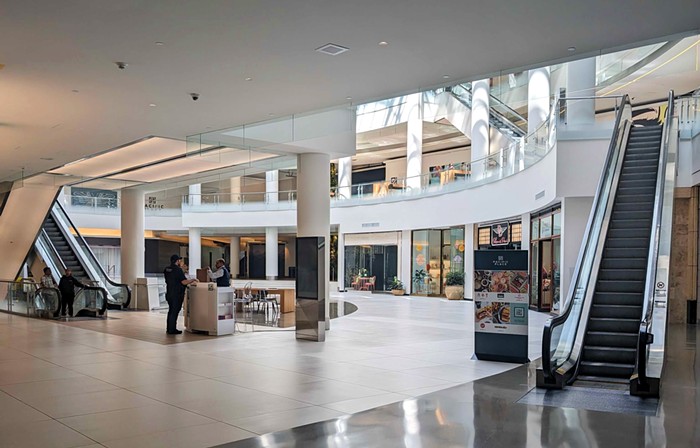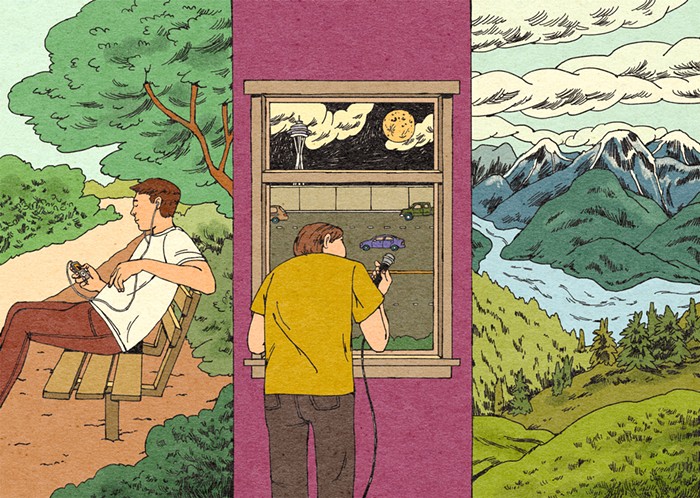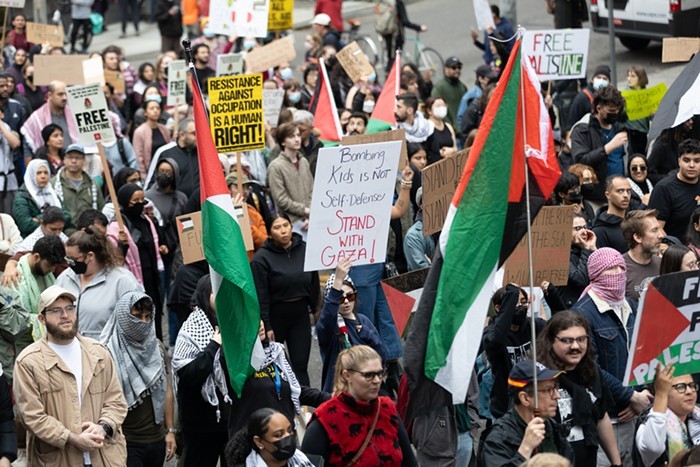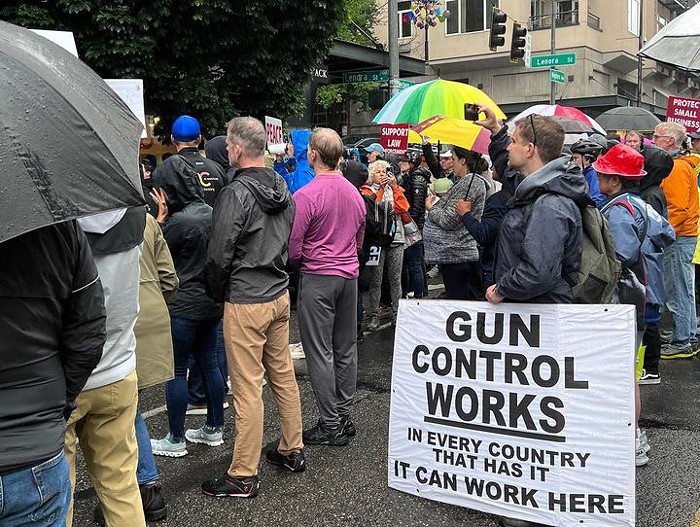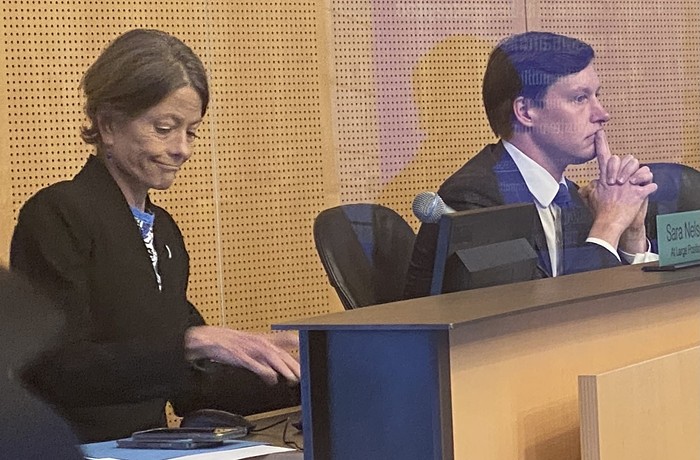What a difference time makes. And yet, the story is always the same. We begin with euphoria and end in depression. In 1998, the Seattle Times celebrated (though with some reservations—it feared the 1997 Asian Financial crisis would spread to our region) the opening of Pacific Place. The mall was part of a $400 million revitalization project that included the relocation of Nordstrom, a sky bridge, and a new office building, all promising to transform the supposedly blighted urban core into a consumer magnet. "Pacific Place, [a] retail-cinema-restaurant complex," wrote Seattle Times, "will add glitz and variety to downtown Seattle, [when it] opens Thursday at Sixth Avenue and Pine Street."
A little more than 20 years after that blast of optimism, the same paper was unremittingly gloomy about the vertical mall's future. It had just completed a long (two-and-a-half years) and disruptive renovation that left almost everyone cold. Though the mall's new look seems "pristine," wrote the Seattle Times in 2020, it's "for the wrong reason: There are barely any stores."
The owner of Pacific Place at the time was Madison Marquette. The Washington, D.C.-based real estate company purchased the property in 2014 for a whopping $271 million. A little later, it also bought the parking lot, which has more levels (six) than the building (five), for $87 million from the city. And so, more than $350 million was poured into Pacific Place. At the end of last week, on May 17, Puget Sound Business Journal reported the block-big and capital-losing mall (it only has about 15 tenants) had been sold to LA's BH Properties. The price tag was, unlike the sale of 2014, kept under wraps.
Pacific Place was doomed from the get-go, from the moment the idea of it was conceived by one of the founding members of Pine Street Development, Jeff Rhodes. The year was 1994. The plan was to think big. The belief was that the shock of a huge investment would restore the heart of downtown. The money for the plan came from many sources, including Kenny G, and the city provided the project with institutional support and a negative pick up on the massive parking lot. (Once the mall was fully operational, Mayor Norm Rice promised to buy and run the 1,200 subterranean parking units with the public's purse.)

But the developers, who claimed to have long experience in the business, made two huge miscalculations. Both were at a macro/social/historical level. One concerned the then-in-progress decline of the suburbs and the form of its culture (cars, malls, low density). The other concerned the rise of online retail, which, at the time, was still in its infancy. The former was a clear and present danger. The latter, admittedly, was still obscure, despite the dot-com bubble, which, after bursting in 2000, numbered Amazon as one of its survivors. But mall culture was already in trouble in the mid-1990s because a growing portion of the public saw its sea-sized parking lots, its simulation of community feeling, and its impersonal goods in a negative light. Even by the 1980s, suburban culture faced the rising and relentless criticism of new urbanism. By the 1990s, the anti-car and pro-density principles of this movement had reached the mainstream. And yet the developers decided to transpose the suburbs, whole hog, to exactly where many had moved to escape it.
As if that wasn't enough, the city devoted millions that could (should) have gone to affordable housing (increased density) to a parking lot that was so costly it became ammunition for the new urbanist cause. In the popular book Walkable City, Jeff Speck, using the research of parking professor Donald Shoup, pointed directly to the fact that Seattle had spent more than $60,000 for each stall below the mall. This was an extreme example of how the government subsidizes a large part of car culture. (Capitalism is never as cheap as it looks.) In fact, the city was ripped off when it purchased the parking garage. Seattle paid $73 million to own what cost $50 million to build, lost money maintaining the damn thing ("about $1.5 million a year"), and sold it for a song (only $87 million).
The parking lot is also said to have cost Mayor Norm Rice his chance at the big time, the Clinton Administration. He was the top runner for Secretary of Housing and Urban Development but was unceremoniously dropped when the vetting process likely revealed that he had directed HUD money to a project that was, in essence, for the rich and not the hard-working poor. Seattle Times of course called this interpretation of the fiasco a "cheap shot" in its 1996 article "Rice's Loss Of Hud Job Is City Of Seattle's Gain."
Even the architecture of the mall was out of time with the times. As the blogger for the Buildings of Seattle, Keith Cote, explained, its postmodern style was in the "death throes" by "the late 1990s." Though Cote is "a huge fan" of this kind of architecture, its "later phase... especially when applied to shopping centers, often resembles a train wreck." Cote is also amazed that "such a bloated design and creative bankruptcy came from such a prestigious firm as NBBJ." (NBBJ is the Seattle-based firm that designed Amazon's headquarters and the Spheres.)
Let's now turn to Amazon and the decline of brick-and-mortar shopping. When Madison Marquette purchased Pacific Place for loads of money, Seattle was in the middle of an economic boom driven by the tech sector. Downtown's property values were skyrocketing. The future looked ever so bright. The mall was "90 percent leased and anchored by Barnes & Noble and AMC Theatres." But in 2017, Madison Marquette apparently got greedy. It wanted to attract the deep pockets of tech workers by renovating the mall's interiors and cramming a brazenly bougie entrance into the southwest section of Pacific Place that directly faced the gateway to South Lake Union. When the disruptive project was finally completed in 2020 for lord knows how much, "two-thirds of the mall’s tenants" were history. And so, Madison Marquette saw the revenue stream of nearly full occupancy drop to a 21-tenant rivulet. "Barneys New York, Barnes and Noble, Victoria’s Secret, Brookstone, J. Crew" and more left during renovation.

Then the pandemic hit, then the US economy lost a mind-boggling 22 million jobs, then the mall was directly hit by the Black Lives Matter revolt. Lululemon, the Canadian athletic apparel retailer offered a ray of hope. It moved into a larger space in the winter of 2020. But a little more than two years later, it called it day. With this departure, KUOW wasted no time calling the Pacific Place a "Ghost Mall." To make matters worse, one of its remaining tenants is called Ghost Gallery. Of the 10 or so times I visited the place in April and May, I never saw this gallery open once. The same goes for a number of other businesses on its second, third, and fourth floors, which at one point were to be converted into office spaces by a bold developer based in LA (the plan tanked in the fall of 2022). As for the celebrated European-style atrium, its inactivity and emptiness are only made more visible by the merciless light falling from the mall's massive skylight.
Only the top floor has businesses (restaurants and a cinema) that attract customers. Indeed, the vertical mall has become something like a floating strip mall. When you look down from this busy level, you see lots of security guards, a few people heading up to where you are, bad art here and there, and a large amount of capital that's "like a patient etherized upon the table."
View this post on Instagram


